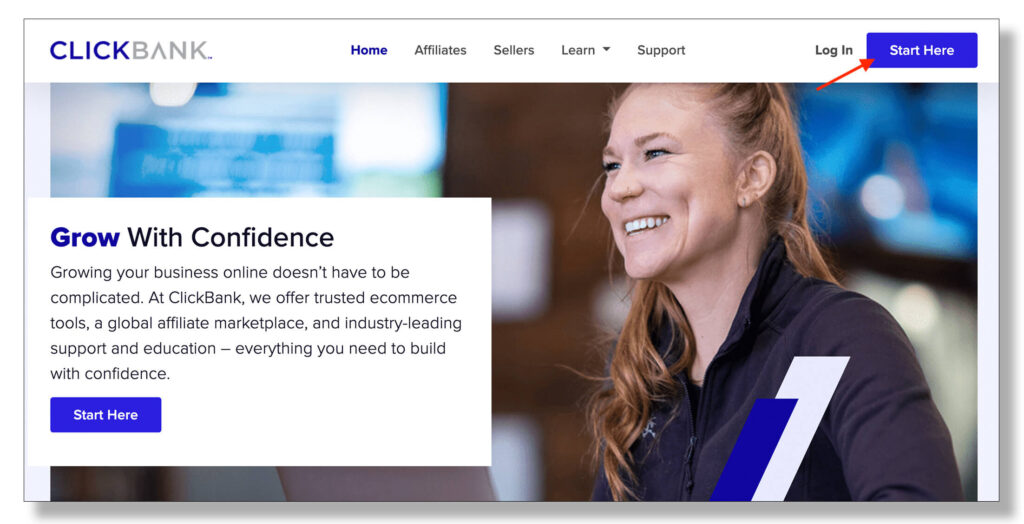Are you ready to dive into the world of ClickBank affiliate marketing but don’t know where to start? You’re not alone! ClickBank is a popular platform with a wide range of digital products, making it an attractive option for affiliate marketers.

In this comprehensive guide, we’ll walk you through the essential steps to begin your ClickBank affiliate marketing journey. Whether you’re a complete beginner or looking to refine your approach, we’ve got you covered.
So, let’s get started!
Understanding the Basics of Affiliate Marketing
Before we delve into the specifics of Clickbank, let’s make sure you have a solid grasp of the fundamentals of affiliate marketing. At its core, affiliate marketing involves promoting products or services created by others and earning a commission for each sale made through your unique affiliate link.
What is Affiliate Marketing?
Affiliate marketing is a performance-based marketing strategy where individuals (affiliates) promote products or services created by other companies (merchants) through unique affiliate links. When a customer makes a purchase through the affiliate’s link, the affiliate earns a commission, usually a percentage of the sale.
More>> What is CJ Affiliate Marketing?
The Roles of Affiliates and Merchants
Affiliates act as intermediaries between the merchant and potential customers. Their primary role is to introduce the merchant’s products to their audience through various marketing channels. Affiliates can range from individuals with blogs and social media accounts to larger entities like websites and influencers. Merchants, on the other hand, provide the products or services and set up affiliate programs to track and reward affiliate-generated sales.
The Affiliate Link and Tracking
The cornerstone of affiliate marketing is the affiliate link. This link is unique to each affiliate and contains a tracking code. When a potential customer clicks on the affiliate link and makes a purchase, the tracking code allows the merchant’s system to identify which affiliate referred the sale. This is crucial for accurately attributing sales and calculating commissions.
Types of Compensation Models
Affiliate marketing operates on various compensation models, each offering distinct advantages:
- Pay-Per-Sale (PPS): Affiliates earn a commission for each sale made through their affiliate link. This is the most popular model.
- Pay-Per-Click (PPC): Affiliates earn money based on the number of clicks their affiliate links receive, regardless of whether a sale is made.
- Pay-Per-Lead (PPL): Affiliates earn a commission when their referred leads take a specific action, such as signing up for a newsletter or filling out a contact form.
Ethics and Transparency
Maintaining trust and credibility is paramount in affiliate marketing. Affiliates should always disclose their affiliate relationships to their audience, ensuring transparency and honesty. This transparency builds trust and helps maintain the authenticity of the affiliate’s recommendations. Additionally, affiliates should focus on promoting products that align with their niche and genuinely provide value to their audience.
Choosing Your Niche and Products
Your choice of niche and products can significantly impact your success as an affiliate marketer. Here are five essential points to consider when making these crucial decisions:
1. Identify Your Interests and Expertise
Start by reflecting on your passions, interests, and areas of expertise. Selecting a niche that aligns with your knowledge and enthusiasm ensures that you can create content that resonates with your audience authentically.
Related: How to Find Super Profitable ClickBank Products
2. Research Market Demand
While personal interest is important, it’s equally vital to assess the market demand for your chosen niche. Conduct thorough research to understand whether there’s a sizable audience actively seeking products or solutions within your niche.
3. Consider Profitability
Balancing your passion with profitability is crucial. Look for niches that not only interest you but also have the potential to generate substantial earnings. Explore the average commission rates in different niches, as some niches may offer higher commission percentages than others.
4. Evaluate Product Quality and Reputation
Before promoting any products, evaluate their quality and reputation. Your credibility as an affiliate marketer is on the line when you recommend products to your audience. Choose products from reputable merchants that offer value to customers.
5. Analyze Competition and Differentiation
Competitive analysis is essential to understand the landscape you’re entering. While competition can indicate a healthy market, it’s crucial to identify ways you can differentiate yourself from other affiliates.
Related: How to Find Profitable ClickBank Products that Sell Fast in 2023
By combining your interests with market demand, considering profitability, assessing product quality, and planning for differentiation, you can make informed decisions that pave the way for a rewarding affiliate marketing experience.
Registering and Setting Up Your Clickbank Account
Now that you’ve chosen your niche and products, it’s time to set up your Clickbank account. Here are the essential steps to follow:
1. Visit the Clickbank Website and Sign Up
Begin by visiting the official Clickbank website. Once there, look for the “Sign Up” or “Create Account” button. Click on it to initiate the registration process. You’ll be prompted to provide essential information, including your name, email address, and a secure password.
2. Complete Your Profile Information
After the initial sign-up, Clickbank may ask you to provide additional details to complete your profile. This could include your payment preferences, such as your preferred method for receiving commissions. Accurate information is crucial here, as it ensures you receive your earnings without any hitches.
3. Understand Clickbank’s Policies
Before you start exploring the platform, take some time to familiarize yourself with Clickbank’s policies and guidelines. This includes understanding the terms of service, commission structure, and rules for promoting products. Being well-versed in Clickbank’s policies will prevent any unintentional violations that could jeopardize your account.
4. Navigate the Clickbank Dashboard
Once your account is set up, you’ll have access to the Clickbank dashboard. This is where you’ll find a wealth of information, including the Clickbank marketplace with its myriad of products, your affiliate links and tracking codes, and your sales and earnings data. Spend time exploring the dashboard’s features to understand its layout and functionality.
5. Generate Your Affiliate Links
One of the key tasks in setting up your Clickbank account is generating your affiliate links. These unique links are how Clickbank tracks the sales you generate. When logged into your dashboard, navigate to the marketplace, select the products you want to promote, and generate your affiliate links. These links will be used in your promotional efforts to ensure you receive proper credit for your referrals.
By following these steps, you’ll be well-equipped to dive into the world of Clickbank affiliate marketing. Keep in mind that this initial setup is just the beginning; your dedication to learning, strategizing, and creating valuable content will ultimately determine your success as an affiliate marketer.
Promoting Your Affiliate Products
Promotion is the heart of affiliate marketing. It’s where you put your skills and creativity to work, connecting products with potential buyers and earning commissions in the process. To excel in this essential aspect of affiliate marketing, consider these five effective strategies:
1. Create Valuable Content
Content is king in the world of affiliate marketing. Whether you’re blogging, making videos, or using social media, focus on producing high-quality content that provides value to your audience. Inform, educate, entertain, and address the needs and concerns of your target audience.
Related: How to Promote ClickBank Products Without a Website
2. Utilize SEO Techniques
Search Engine Optimization (SEO) is a powerful tool for driving organic traffic to your content. Conduct keyword research related to your affiliate products and incorporate these keywords naturally into your content. This enhances your content’s visibility on search engines, increasing the chances of reaching users actively seeking information about the products you’re promoting.
3. Leverage Social Media Platforms
Social media platforms provide an excellent avenue for reaching a wide audience. Identify the platforms where your target audience is most active and engage with them through regular posts, stories, and interactions. Share valuable content, including reviews, tutorials, and product comparisons, and remember to use your affiliate links strategically.
4. Build an Email List
Email marketing remains a potent strategy for promoting affiliate products. Create an email list by offering valuable content in exchange for your audience’s email addresses. Once you have a list, send out newsletters featuring your affiliate products, exclusive offers, and insightful content. Personalized email campaigns can foster stronger connections and higher conversion rates.
5. Incorporate Visual Content
Visual content, such as images and videos, is highly engaging and effective in conveying information. Create eye-catching graphics, infographics, and video content that showcase the benefits of the products you’re promoting. Visuals can capture your audience’s attention and convey messages more effectively than text alone.
By creating valuable content, utilizing SEO techniques, leveraging social media, building an email list, and incorporating visual content, you can effectively reach and engage your target audience. Remember that success in affiliate marketing takes time and persistence. Continuously refine your strategies based on performance data, stay up-to-date with industry trends, and always prioritize providing genuine value to your audience. With dedication and the right approach, you can turn your promotional efforts into a rewarding affiliate marketing venture.
Analyzing Performance and Optimizing
Once you’ve embarked on your affiliate marketing journey and started promoting products, the next crucial step is to analyze your performance and optimize your strategies. Here are five essential points to guide you through the process:
1. Utilize Analytics Tools
Analytics tools are your best friends when it comes to evaluating your performance. Platforms like Google Analytics, Clickbank’s reporting features, and social media insights provide valuable data on metrics such as clicks, conversions, bounce rates, and engagement levels. Use these tools to gain insights into what’s working and what needs improvement.
2. Track Conversions and Earnings
The ultimate goal of your affiliate marketing efforts is to drive conversions and earn commissions. Regularly monitor your conversion rates and earnings to understand which products and strategies are generating the most revenue. This data helps you focus your efforts on the most profitable avenues.
3. Identify High-Performing Content
Analyze your content to determine which pieces are resonating most with your audience. Look for trends in the type of content, format, and topics that lead to higher engagement and conversions. This information guides your content creation efforts and helps you replicate success in future campaigns.
4. A/B Testing for Optimization
A/B testing involves creating multiple versions of your content or marketing campaigns and comparing their performance. This technique can help you refine your strategies by identifying which variations lead to better results. Test different headlines, calls-to-action, visuals, and even the placement of your affiliate links to discover what resonates best with your audience.
5. Stay Adaptable and Evolve
Affiliate marketing is a dynamic field, and what works today might not work as effectively in the future. Be prepared to adapt and evolve your strategies based on changing market trends, audience preferences, and technological advancements. Regularly review your performance data and be willing to pivot your approach to stay relevant and effective.
By utilizing analytics tools, tracking conversions and earnings, identifying high-performing content, conducting A/B tests, and staying adaptable, you ensure that your efforts remain effective and yield the best possible results. Remember, the affiliate marketing landscape is always evolving, so your commitment to continuous improvement will be the driving force behind your long-term success as an affiliate marketer.
FAQs About ClickBank Affiliate Marketing
What is Clickbank affiliate marketing?
Clickbank affiliate marketing is a performance-based marketing strategy where individuals promote products or services created by other companies through unique affiliate links and earn commissions for each sale made through those links.
How do I choose the right niche for Clickbank affiliate marketing?
To choose the right niche, consider your interests, expertise, market demand, profitability, and the quality and reputation of products within the niche. Balancing your passion with profitability is key.
What are the different compensation models in affiliate marketing?
The most common compensation models in affiliate marketing are Pay-Per-Sale (PPS), Pay-Per-Click (PPC), and Pay-Per-Lead (PPL). Each model offers distinct advantages for affiliates.
How can I effectively promote Clickbank affiliate products?
To promote Clickbank affiliate products effectively, create valuable content, utilize SEO techniques, leverage social media platforms, build an email list, and incorporate visual content. Providing value to your audience is crucial.
What should I do to analyze and optimize my affiliate marketing performance?
To analyze and optimize your affiliate marketing performance, use analytics tools, track conversions and earnings, identify high-performing content, conduct A/B testing, and stay adaptable to changing market trends and audience preferences.
Thank you for reading our comprehensive guide on starting your Clickbank affiliate marketing journey. We hope this information helps you kickstart a successful and rewarding venture in the world of affiliate marketing.



